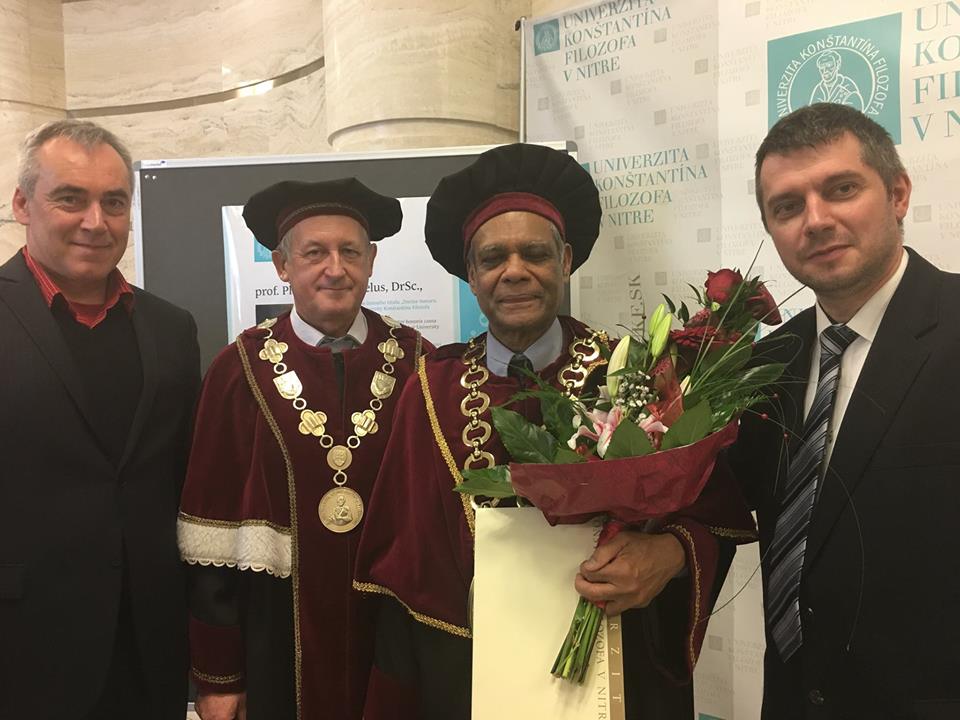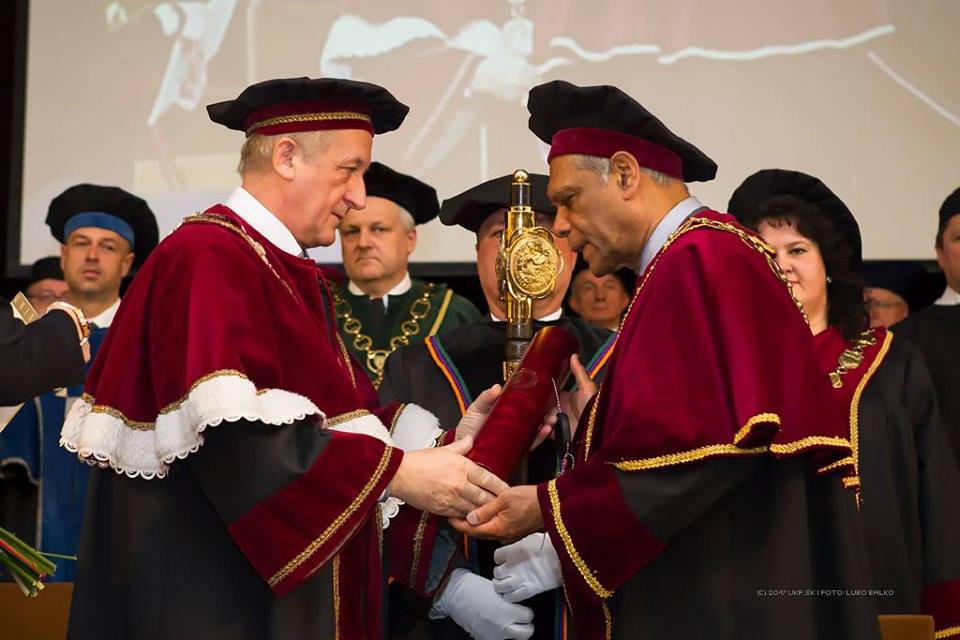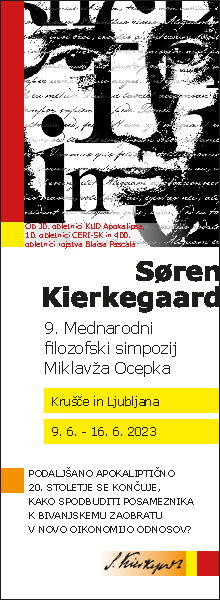 In the beginning of march 2017, the director of CERI - SK Dr. Primož Repar atended the ceremony at the University of Constantine the Philosopher in Nitra (Slovakia) where prof. Abrahim Khan was awarded with the title Doctor honoris causa. Prof. Khan was involved in many activities of the CERI - SK institute and we congratulate him for the honor that he received.
In the beginning of march 2017, the director of CERI - SK Dr. Primož Repar atended the ceremony at the University of Constantine the Philosopher in Nitra (Slovakia) where prof. Abrahim Khan was awarded with the title Doctor honoris causa. Prof. Khan was involved in many activities of the CERI - SK institute and we congratulate him for the honor that he received.
Inauguration speech
Mr. Rector and Vice-rectors,
Deans and Vice-deans,
Heads of Department and Directors of programs,
Colleagues, students, and invited guests
In the 1979 American comedy film Being There actor Peter Sellers as Chance the Gardener underscores a memorable maxim: “Showing up is 80% of life.
”Ďakujem for showing up to make this occasion a celebratory one.
It never dawned on me that my academic and research activities would get me here. Chance and the kindness of others have undoubtedly had a role. Excavated for this occasion are three likely ones–chance happenings:
In 1964, the theologian Paul Tillich was lecturing at the University of Maryland on religion and contemporary developments. I was an undergraduate at Howard in Washington DC and by chance I happened to attend. Tillich was asked about God and the world with reference to the second law of thermodynamics. The question caught my attention, being a physics major. It was all I can recall of the lecture, perhaps still theologically naïve at that time.
Years later, in 1998, I was a senior fellow at Harvard University’s Center for the Study of World Religions. Theologian Harvey Cox and a former Dean of Harvard Medical School were going to visit the Artificial Intelligence Lab at MIT. By chance I was invited to go along, and learned that Tillich was a frequent visitor there in conversation about artificial intelligence. Later, I would ponder whether persons, as opposed to humans, could ever be artificially created. The notion of ‘person’ would come to underlie much of my thinking and publications and remains so. Meet Sophia, the latest human-like robot. It walls, talks, thinks, makes eye contact, has 67 interactive facial gestures, and resembles actress Audrey Hepburn. (Legal affairs committee of EU parliament is looking into the questions of personhood status for robots) Clearly, it is becoming more difficult to tell whether the other with whom we are falling in love, or sitting next to us, is real or fake.
A brief excursus—the 1998 Harvard University stint offered other fleeting opportunities. One was an invitation to the Friday morning sessions that the psychiatrist and anthropologist Arthur Kleinman convenes. He was responsible for adding the culture axis in the DSM-IV classification of mental disorders. That year he was giving the William James Lecture at Harvard on suffering and was particular interested to have my response to it.
Another Harvard opportunity was attending the Wednesday lunch seminars of the Nieman fellows: 24 young journalists from around the world appointed each year for a learning opportunity. On two or three occasions I got invited to the closed shop seminars. One that made a lasting impression was by a Central European journalist on the recent convictions for genocide in Bosnia. It opened another perspective for me, deepening considerations as did conversations with Harvard colleagues: Cornel West, Amartya Sen, Anthony Appiah, and Stanley Tambiah. These discussions still resonate in my head and no doubt helped to shape my own ideas and lines of research.
 A second happenchance, in August 1965, was meeting with a Czech scholar, Milan Opočenský, two weeks before starting my studies in theology at Yale. He was recommending the study of ethics, while my mind was set on philosophy of religion. Later, I came to find interesting his idea of dialogue as a methodological approach that implies an inner dialogue by which an individual matures. Deeply interested in Marxist-Christian discussion, and influenced by Milan Machovec and Josef Hromádka, he participated in the Monday Seminar started by the Philosophy Faculty at Charles University. The Seminar provided a platform for that dialogue and broadened to include topics like Buddhist ontology, Chinese view of man, and Kierkegaard as a thinker. Opočenský`s idea converged later with my interests in interreligious dialogue and the idea of becoming a person. Those interests were deepened, having been sparked originally by encounters with the cross-cultural, Indo-Spanish, philosopher-theologian, Raimundo Pannikar, and by the Canadian historian of religion and Islamicist, Wilfrid Cantwell Smith.
A second happenchance, in August 1965, was meeting with a Czech scholar, Milan Opočenský, two weeks before starting my studies in theology at Yale. He was recommending the study of ethics, while my mind was set on philosophy of religion. Later, I came to find interesting his idea of dialogue as a methodological approach that implies an inner dialogue by which an individual matures. Deeply interested in Marxist-Christian discussion, and influenced by Milan Machovec and Josef Hromádka, he participated in the Monday Seminar started by the Philosophy Faculty at Charles University. The Seminar provided a platform for that dialogue and broadened to include topics like Buddhist ontology, Chinese view of man, and Kierkegaard as a thinker. Opočenský`s idea converged later with my interests in interreligious dialogue and the idea of becoming a person. Those interests were deepened, having been sparked originally by encounters with the cross-cultural, Indo-Spanish, philosopher-theologian, Raimundo Pannikar, and by the Canadian historian of religion and Islamicist, Wilfrid Cantwell Smith.
A third happenchance was to have as my doctoral thesis advisor, in 1971, a philosopher shaped by the analytic tradition, Alastair McKinnon at McGill University. He approached the Kierkegaard Corpus by paying attention to quantitative details of language. At the heart of his work was the idea that Kierkegaard as a writer is trying to transmit a picture to his reader, using words at an aberrant rate to make a point.
Following McKinnon, my envisioning was to represent each Kierkegaard text in accordance with 15 or so key terms displayed in multidimensional space. Doing 34 books comprising the Kierkegaard Corpus is a large undertaking. When finished, it would offer a very relevant alternative to interpreting each text, in light of what is actually there—as the details are ascertained objectively, orderly and with methodological rigour.
These happenchance events augmented my university education. Course lectures and discussions opened up new vistas, increased knowledge base, sharpened critical thinking, and taught me how to ask pertinent questions at an opportune time and in the right measure for different disciplines. Chance favors the prepared mind seeking to combine theory with practice. The Greek term kairos references that correlation. For Paul Tillich and Walter Benjamin (cultural critic and philosopher) kairos is an awareness of the revolutionary possibilities inherent in the now–time, the potential for change in a historical situation, for acting existentially. The term has an ethical and an epistemological dimension, and implies a skillful recognition of opportune moment and right measure.
These chance happenings have been for me kairos that opened the way for a collaborative undertaking with Slovakia and elsewhere. When an email comes to the Kierkegaard Circle seeking an answer, I respond without hesitation. One of those requests, over a decade ago, was from a student in Prague about to defend his doctoral thesis. I am talking about your present colleague Prof. Králik from whom more questions followed, eventually leading to the Acta Kierkegardiana and the Central European Research Institute on Soren Kierkegaard (CERISK). The work of the Institute has a collaborative reach beyond Slovakia and Europe. It includes as a focal point of activity a branch – the Kierkegaard Institute in Ljubljana. The branch recently entered into formal collaborative understandings with Žilina University, and with Cyril and Methodius University in Macedonia.
CERISK’s literary output is more than the internationally recognized Acta Kierkegaardiana Series. It includes a supplement and a monograph stream. They make available research and results of Central European scholars. They form a matrix for inner cultural dialogue that contributes to the maturing of CERISK as a dialogical partner in Kierkegaard Studies, through publications and outreach, and by facilitating a synergy of talents and abilities of individuals in collaboration. The result goes beyond what any scholar would dream of doing alone in an academic context.
The modern research university encourages such synergies. It has for its methodology or analytic inquiry – testability, theoretical refinements, and whatever is deemed to be constitutive of procedural rationality to yield public knowledge and facts. This methodology is seemingly but never neutral; invariably tied to social imaginaries and historical constructs that reference modes of understanding social and cultural life. They are constitutive of epistemes that are limited and that remain invisible to those operating with them. Strategic partnership programs at the modern university invite us to engage a diversity of approaches which make us more aware of the epistemes or background understanding that determine research lines and outcomes.
Collaborative projects across disciplines and cultures increase opportunities for creativity. I am suggesting here that creative imagination is a key element in the process of education—enabling us to become the accomplished scholars, innovative scientists, outstanding artists, inspiring teachers, risk-taking entrepreneurs, and promising socio-political leaders–– all needed to address the challenges of the complex modern society. We need to frame questions that matter, that put to rest fear of difference, that neutralize polarization of communities and societies, and instead that encourage natural diversity and complementarity, in creating a thriving environment.
In conclusion, let me insist that the modern university must be committed to educating the mind as well as cultivating the creative imagination. This way we will be more effective in widening the frontiers of knowledge, empowering our communities, and opening up space for each other to earnestly inquire: Am I living as a fake, or as one conscious of becoming a true person?
Ďakujem for the honour and opportunity to offer some thoughts about our shared task.
Afterword
The painting ``Starry Sky Attempt`` by Wenzel Hablik of Upper Bohemia (born in Most, just outside Prague) has been on mind while composing for this occasion. His 1909 painting forces one to do exactly what Wittgenstein would encourage –look at details rather than confirm to narrow possibilities. The painting presages what will follow a few decades later in space exploration. CERISK and Central European scholars and students of all disciplines have available in Hablik’s Starry Sky Attempt, a paradigm or source of reflection for academic work and coaxing of the creative imagination
Abrahim H. Khan
Trinity College, University of Toronto
This email address is being protected from spambots. You need JavaScript enabled to view it.



